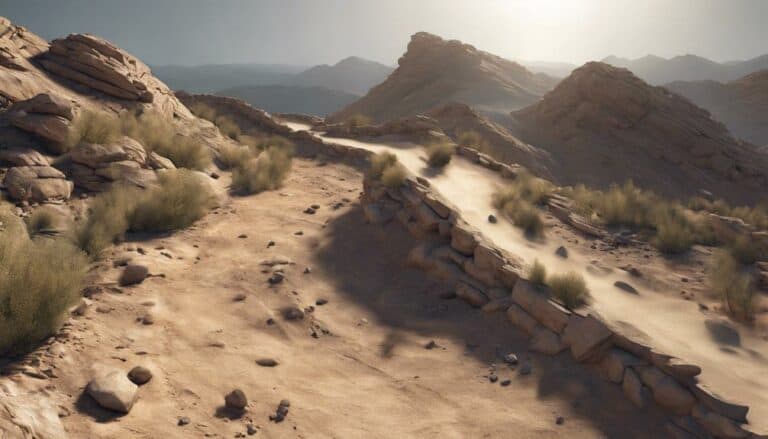When tackling different terrains on a dirt bike, the key to mastering braking lies in understanding how the terrain influences your approach. From sandy dunes to muddy trails, each surface demands a nuanced braking strategy to navigate safely and effectively.
By considering the terrain's unique characteristics, you can optimize your braking style to enhance control and responsiveness, ultimately elevating your riding experience.
So, how exactly does terrain impact your braking decisions on a dirt bike? Explore the intricate relationship between terrain and braking styles to elevate your off-road riding skills.
Key Takeaways
- Terrain influences braking style selection based on surface characteristics.
- Nuanced braking strategies are crucial for efficiency and control on varied terrains.
- Adaptability in braking style is essential to match surface conditions.
- Mastery of brake control techniques is vital for safe and effective dirt bike riding.
Importance of Terrain in Braking
Considering the diverse nature of terrains encountered while riding a dirt bike, understanding the impact of terrain on braking performance is important for maintaining control and safety. Body positioning plays a critical role in optimizing braking efficiency. When approaching a varied terrain, adjust your body position to distribute weight evenly for better stability. This adjustment aids in maximizing the effectiveness of both the front and rear brakes.
The front brake is necessary for quick and efficient stopping power on dirt, but the level of grip available varies based on the terrain. In loose gravel or rocky surfaces, be cautious with the front brake to prevent skidding. In such conditions, relying more on the rear brake can help maintain traction and control.
Different terrains demand adaptability in braking style. Rough terrains require quicker reactions and a lighter touch on the brakes to navigate obstacles smoothly. By understanding how terrain affects braking, you can anticipate challenges and adjust your approach accordingly for safer and more efficient dirt bike control.
Impact on Brake Control
Terrain greatly impacts brake control on a dirt bike by directly influencing traction levels and the bike's overall stability. When considering brake control on different terrains, keep in mind the following:
- Front Wheel: Adjusting the front brake pressure is important for maintaining control, especially when maneuvering steep descents or sharp turns.
- Rear Wheel: Proper modulation of the rear brake prevents skidding and enhances stability, particularly on loose or uneven surfaces.
- Riding Technique: Your body positioning and weight distribution play a significant role in brake control. Leaning back slightly under hard braking can prevent the front wheel from locking up.
- Adaptation: Being able to quickly adapt your braking style to the changing terrain increases your overall safety and control, allowing for smoother rides and quicker reaction times.
Mastering brake control on varied terrains involves a blend of finesse, technique, and adaptability, ensuring a safer and more enjoyable dirt biking experience.
Adapting to Different Surfaces
Adjusting your braking technique is important when encountering different surfaces on a dirt bike, as it directly impacts your control and stability.
When riding on diverse terrains like loose gravel, mud, sand, or rocks, you need to adapt your braking style to maintain traction and prevent accidents. Understanding the influence of factors such as surface grip, incline, and obstacles on your braking distance is essential for safe dirt riding.
Proper cross training can help you develop the skills needed to adjust your braking technique effectively based on the terrain you're exploring. Additionally, being mindful of your center of gravity and how it shifts on different surfaces can aid in modulating brake pressure to avoid skidding and maintain stability.
Adjusting Braking Techniques
When riding a dirt bike, mastering the art of adjusting braking techniques is important for maintaining control and safety on varied terrains. Terrain influences braking technique by dictating the amount of traction available for stopping or slowing down.
Here are some quick tips to help you adjust your braking techniques effectively:
- Common Problem: Riders often face the common problem of locking up the brakes on loose surfaces. To avoid this, modulate brake pressure smoothly.
- Quick Note: Remember to keep your body weight slightly forward while braking to prevent the rear wheel from skidding out.
- Keep the Bike: In situations where the terrain is slippery, focus on using both brakes evenly to keep the bike stable and under control.
- Adapt Timing: Adjust your braking timing to match the terrain; for example, start braking earlier on slick surfaces to allow for a longer stopping distance.
Terrain-Specific Braking Tips
To optimize your dirt bike braking performance across various surfaces, consider employing terrain-specific braking techniques tailored to each type of ground you encounter.
When riding on hardpack dirt, you can be more aggressive with your braking to stop the bike quickly. Remember to shift your weight slightly backward to prevent the front wheel from washing out.
In contrast, on loose or sandy terrain, a more delicate touch is required to avoid skidding. Feather the brakes gently to maintain traction and control.
When traveling over rocky terrain, precise braking is essential to prevent wheel lock-up. Control your speed by modulating the brakes smoothly, allowing the tires to grip the uneven surface.
Wet or muddy surfaces pose another challenge, necessitating a gentle application of brakes to prevent skidding. Anticipate stops early, brake progressively, and use engine braking to hang back and maintain stability.
Understanding these terrain-specific tips will enhance your ability to stop effectively and safely on diverse surfaces.
Conclusion
To sum up, terrain plays a vital role in determining the appropriate braking style for a dirt bike. By understanding the impact of surface conditions, traction levels, and obstacles on brake control, riders can adapt their techniques to guarantee maximum safety and performance.
Remember, mastering terrain-specific braking tips is key to conquering any challenge on your dirt bike. So, next time you hit the trails, be sure to brake with precision and finesse, like a well-oiled machine gliding effortlessly through the rugged landscape.

